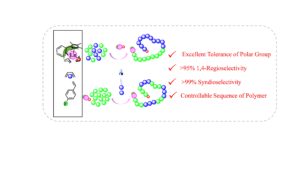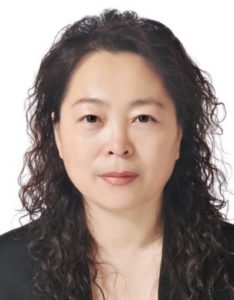Synthetic rubbers have played an irreplaceable role in our morden society since we are living in the world “on wheel“. On the other hand these materials are difficult to be reused and recycled and nearly impossible to be bio-degradated, which are the main source of “black pollution“. For the sustainable development of the tyres and rubber industries, to fabricate “green tyres“ has been the challenging project in the past three decades. Styrene-butadiene rubber (SBR) is the most widely applied synthetic rubber in the passenger cars, which mixing with functionalized fillers, has been employed to fabricate “green tyres“. One of the strategies is synthesizing functional SBR to improve their compatibility with polar fillers, anticipated to endow the tyres excellent wear-resistance (prolonged use time) and low-rolling resistance whilst not sacrifice the wet-skid resistance.
Radical and ionic (co)polymerizations of polar monomers were usually adopted to produce functional poly(styrene-butadiene), while the obtained polymers were provided with poor regularity. By contrast, coordination polymerization was powerful in controlling microstructure of polymer chains, however, functional groups were usually poisonous to the applied catalysts.
Recently, the group of Dongmei Cui have demonstrated that syndio- and cis-1,4 dually selective copolymerization of para-fluorostyrene (pFS) and butadiene (BD) using rare-earth metal catalysts and di- and multi-block P(pFS-BD) copolymers were successfully synthesized by switching the monomers’ loading modes.
The authors firstly copolymerized of pFS and BD using pyridyl-methylene-fluorenyl supported complexes[(Py-CH2-Flu)Ln(CH2SiMe3)2(THF)n (Ln = Sc (1a), n = 0; Ln = Lu (1b), n = 1)]. The polymerization catalyzed by 1a gave a crosslinked copolymer because the scandium active species initiated the polymerization of the dangling C=C bonds of the 1,2-regulated PBD segments. Catalyst 1b showed low activity and poor controllability. Interestingly, by using pyridyl-cyclopentadienyl supported complexes[(Py-Cp)Ln(η3-C3H5)2 (Ln = Sc (2a), Lu (2b))] , which provided the active rare-earth metal center with an open coordination sphere to avoid low cis-1,4 selectivity and cross-linking process, the authors obtained syndio- and cis-1,4 dually regulated poly(fluorostyrene-butadiene). By merit of the livingness characteristics of copolymerizing pFS and BD, a multi-block copolymer was isolated via pulse loading of butadiene.
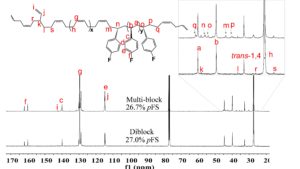 Figure 1. 13C NMR spectra of multi-block and diblock poly(pFS-BD).
Figure 1. 13C NMR spectra of multi-block and diblock poly(pFS-BD).
The microstructures of resultant copolymers were confirmed by 1H and 13C NMR measurements(Figure 1) and different phase morphologies of the di- and multi-block polymers were displayed through atomic force microscopy (AFM) (Figure 2). Strikingly, the multi-block copolymers of a novel type of fluoro styrene-butadiene rubber showd high thermal stability (Td = 368 oC) (Figure 3).
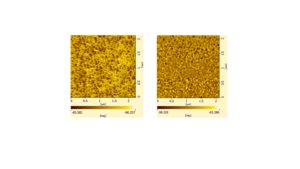 Figure 2. AFM micrographs of a spin-coated thin film of diblock poly(pFS-BD)(left) and multi-block poly(pFS-BD)(right).
Figure 2. AFM micrographs of a spin-coated thin film of diblock poly(pFS-BD)(left) and multi-block poly(pFS-BD)(right).
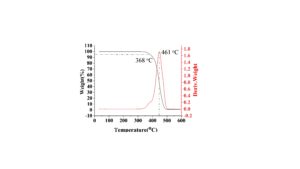 Figure 3. TG and DTG curves of multi-block poly(pFS-BD).
Figure 3. TG and DTG curves of multi-block poly(pFS-BD).
This work designed rare-earth metal catalyts through regulating the electronic and steric effects of ligands to copolymerize para-fluorostyrene and butadiene, which paved a new avenue to access functional styrene-butadiene copolymer with controllable regio- and stereo- regularities as well as sequence distribution.
Corresponding Author
Prof. Dongmei Cui
Changchun Institute of Applied Chemistry, CAS
Dongmei Cui is a professor in State Key Laboratory of Polymer Physics and Chemistry, Changchun Institute of Applied Chemistry, CAS. She received her PhD at Changchun Institute of Applied Chemistry in 2001. The research fields of Professor Dongmei Cui are designing organo-lanthanide catalysts and precisely controlled coordination polymerizations. She has reported more than 180 articles indexed by SCI and has been invited to give several presentations internationally.
Article information:
Syndio- and cis-1,4 Dually Selective Copolymerization of Polar Fluorostyrene and Butadiene using Rare-earth Metal Catalysts
Yuanhao Zhong, Chunji Wu and Dongmei Cui
Inorg. Chem. Front., 2020,
https://doi.org/10.1039/D0QI00719F


